At the end of this I make an admission — but why wait? I prefer Heaven Knows, Mr. Allison to the better known The African Queen, two movies from the same director (John Huston) and superficially similar. I like this movie and always have. But be warned! It’s a quiet one; it’s characterized by restraint.
The strange love of movies – Cinema Paradiso
I last watched Cinema Paradiso about ten years ago. I’ve been meaning to watch it again for a long time but two things have held me back: the length (almost three hours — I don’t ever seem to have the time) and what I fear is a problem with my DVD copy. I hate the idea of getting halfway into a movie then finding a problem prevents me from seeing the rest.
But maybe this weekend I’ll overcome these hesitations. I really do want to see this again. For now, my impressions from when I saw it back around 2003 …
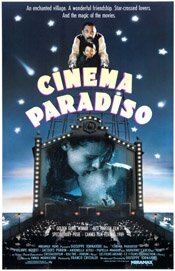 Cinema Paradiso (1988)
Cinema Paradiso (1988)
Directed by Giuseppe Tornatore
My memory is poor, so I really don’t recall the original, theatrical version of Cinema Paradiso. Whether or not the longer version I have (the 2003 DVD release) is better, I’ve no idea. It adds 51 minutes to the film – a 174 minute movie compared to the theatrical release at 123.
This version of Cinema Paradiso is broken into three parts – the main character Salvatore as a child, a young man, and finally as an older man (middle-aged). It begins with a kind of prologue of Salvatore as the older man.
The beautiful opening shot is almost still, like a photograph. Slowly the camera pulls back as the opening credits roll. As we pull back, the image we have is truly a filmmaker’s image: it’s very deliberately staged and framed, and I think we’re supposed to be aware of this. It is still, as if frozen, somewhat like the memories of the character Salvatore.
As the camera continues back, we become aware that we’re looking through a window. Slowly retreating, at one moment it almost looks like a film screen.
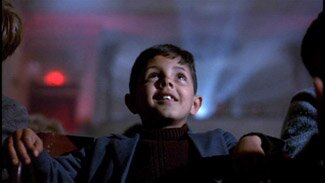 But once the credits are over and we’re at the furthest distance of the pull back, we see we’re in a room in a house. Dialogue begins and we see Salvatore’s mother move into the frame. The serene beauty of the opening shot, the staged nostalgic memory (which is what the opening has been) is disrupted by reality of everyday life.
But once the credits are over and we’re at the furthest distance of the pull back, we see we’re in a room in a house. Dialogue begins and we see Salvatore’s mother move into the frame. The serene beauty of the opening shot, the staged nostalgic memory (which is what the opening has been) is disrupted by reality of everyday life.
The current reality of this beginning (following the opening shot) establishes the kind of life Salvatore is living as a well-known filmmaker. It shows us a man avoiding his past. It gives us a man disconnected from his personal history and disconnected generally with the humanity around him. He’s isolated, and has chosen to be so.
The beginning also is what leads us into the story as it flashbacks to his life as a child, the film’s first section (following its prologue). It’s significant that we get into his childhood this way because it determines what we see and how we see it: it’s through the older Salvatore’s memory. It’s therefore not necessarily true in an objective sense.
This first part, Salvatore as a child (his memory of it), is generally brightly lit. It’s very open and spacious (compare the town square at the beginning of the film to the car-packed square at the end). In fact, everything here is open except for one thing: Alfredo’s little room in the Cinema Paradiso.
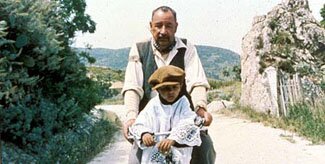 Alfredo, the projectionist at the town of Giancaldo’s movie theatre, the Cinema Paradiso, and who is the key figure in Salvatore’s life, is seemingly imprisoned. With the exception of a few scenes, we almost always see him looking through his window on the square, looking through the small opening in the projection room on the theatre, or loading and unloading reels of film in his cramped projection room. His life is contained by these small confines. He is always an observer. He is never a part of the audience below him in the theatre who seem to be continually chattering and interacting.
Alfredo, the projectionist at the town of Giancaldo’s movie theatre, the Cinema Paradiso, and who is the key figure in Salvatore’s life, is seemingly imprisoned. With the exception of a few scenes, we almost always see him looking through his window on the square, looking through the small opening in the projection room on the theatre, or loading and unloading reels of film in his cramped projection room. His life is contained by these small confines. He is always an observer. He is never a part of the audience below him in the theatre who seem to be continually chattering and interacting.
Like an image on film limited by the frames, his world is constrained by the walls of his projection room. But as the movie’s opening has shown us, and as demonstrated in Sergio Leone’s The Good, The Bad and the Ugly, there is a world beyond the image’s frame (Tori’s mother in the movie’s opening). However much they may delight, or how real they may seem, movie’s are not everything. There is a world beyond them.
In the second part of the movie, Salvatore begins to become like Alfredo, at least this is a choice he is presented with. He takes over the projection booth. But he does have a choice and this is what the second part concerns.
While isolated in the projection booth, he also has a foot in the more tactile and chaotic world of the audience. This is through his relationship with the young woman Elena. In this part of the film, director Guiseppe Tornatore introduces a sexual element – in the films seen in the Cinema Paradiso, in the behavior of the boys of Salvatore’s age, and in Salvatore’s relationship with Elena, though this latter is more romantic in its treatment than sexual.
But the purpose of the sexuality is its relationship to romance and personal connections. It is something that pulls Salvatore away from the isolated world of films into the community of the audience, the town.
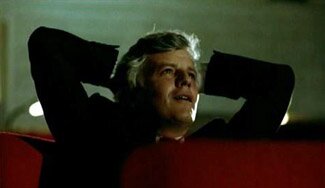 Alfredo, knowing this, and sensing the cinematic artist in Salvatore, undermines the relationship between Salvatore and Elena. This action parallels that of the town’s priest who in the first part of the film had been ordering the censoring of all the scenes involving kisses, scenes that suggested intimacy.
Alfredo, knowing this, and sensing the cinematic artist in Salvatore, undermines the relationship between Salvatore and Elena. This action parallels that of the town’s priest who in the first part of the film had been ordering the censoring of all the scenes involving kisses, scenes that suggested intimacy.
Salvatore’s relationship with Elena no longer a possibility, he now leaves the town (the audience). Alfredo not only supports this decision, he prompts it. He tells Salvatore, “You have to go away for a long time, many years, before you can come back and find your people.”
It’s ironic that Alfredo says this as he has never gone away, at least not physically. It could, however, be argued he has left emotionally and spiritually and has yet to return.
This leads to the film’s third part, the movie’s “now.” The older Salvatore finally returns to the town of Giancaldo. He returns for Alfredo’s funeral (who, in a sense, is finally “going away”). For Salvatore, the return is a series of revelations. As he says himself, he has been afraid to return.
One of his biggest discoveries is of Alfredo’s manipulations to keep Salvatore and Elena apart. She did not betray Salvatore, nor he her. It was Alfredo. His reasons were to force Salvatore out to his career as an artist, a famous filmmaker.
The other revelation is the film’s conclusion where Salvatore sits alone in the theatre watching Alfredo’s final gift, a reel of film. It is all the kisses and other intimate moments of human relationships the priest had removed from the movies. It is as if Alfredo is trying to return the part of life he had removed from Alfredo.
In contrast to the film’s beginning, this final section is visually darker and cramped. It is the real part of the film, as opposed to the remembered.
In this final part, we also see the destruction of the theatre, the Cinema Paradiso. While not the destruction of movies, it seems it’s the destruction of the tyranny of fantasy. While painful, it frees Salvatore from the confines imposed by images. It frees him of the prison art imposes and allows him back into life. We see a shot of young people laughing with a youthful sense of fun as they see the destruction of the building. It’s as if the present is clearing away the past so it can live.
The film appears to have two meanings, or at least two intents. In part, it is a loving homage to cinema and what it gives us. At the same time, it is also about the tyranny of art, at least for the artist. It is about what is denied him or her in order to pursue their art. It seems to say, as an artist you can observe life but you cannot be a part of it. You must remain a step removed. And movies are not real. They are moments; they are memories.
I think the film, at least in its extended version, is less a film about a love of cinema than a film about the sacrifices demanded by art. And while it does not provide an answer, I think it also speculates on the relationship between life and art and which has greater value.
Ernst Lubitsch and his lustfully troubled Paradise
Without really planning too, I’ve found myself watching the movies of Ernst Lubitsch. A few nights ago it was The Shop Around the Corner. Last night it was Trouble in Paradise. I had seen both before, at least once each. What I find interesting is that the more I see them, the more I like them. The first time around you miss how well constructed they are because they evolve so seamlessly. So I definitely recommend seeing them at least twice.
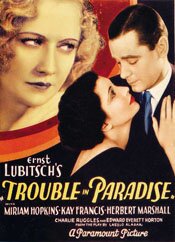 Trouble in Paradise (1932)
Trouble in Paradise (1932)
One of the finest romantic comedies ever made, and one that in many ways created a template and set standards for later romantic comedies (while also looking ahead to the screwball comedies to come), is Ernst Lubitsch’s Trouble in Paradise, made in 1932.
With a single film, American cinema suddenly grew up. In many ways, it’s the most adult film Hollywood has ever made. (Not long after, production codes were put in place and much of what is in Trouble in Paradise would not have been allowed.)
Prior to Lubitsch’s first nonmusical American film, the sophisticated manner and style of this movie hadn’t been seen, not on this side of the Atlantic. Nor had this degree of elevated wit or sexual play.
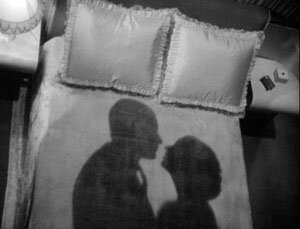 Much is made of the “Lubitsch touch,” and there certainly is such a thing. While a bit hard to define precisely, it has a great deal to do with a European sensibility, one not informed by a Puritan cultural background. It has to do with wit and sophistication and adult romance.
Much is made of the “Lubitsch touch,” and there certainly is such a thing. While a bit hard to define precisely, it has a great deal to do with a European sensibility, one not informed by a Puritan cultural background. It has to do with wit and sophistication and adult romance.
Here, adult means playful, well-mannered and tinged by a degree of melancholy. Trouble in Paradise is a perfect example of this.
The movie is about two charming thieves, their love for one another, as well as their enjoyment of their craft. It’s about the playfulness between them, and the woman whom they choose as their mark.
Herbert Marshall is the thief Gaston Monescu. He charms his way into the life of Mariette Colet (Kay Francis) in order to steal her money. His love, the pickpocket Lily (Miriam Hopkins), is his accomplice.
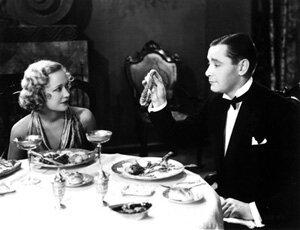 But this is what Hitchcock would call the McGuffin. The movie is really about the triangle that develops as Gaston becomes romantically enchanted by Mariette just as she falls in love with him. All the while, Lily is still there and still loves Gaston, just as he still loves her.
But this is what Hitchcock would call the McGuffin. The movie is really about the triangle that develops as Gaston becomes romantically enchanted by Mariette just as she falls in love with him. All the while, Lily is still there and still loves Gaston, just as he still loves her.
Lubitsch’s direction is nothing less than wonderful here. One of the qualities that characterize his films, especially in Trouble in Paradise, is his refusal to be obvious about anything. He tells his story through indirection and implication, rarely being overt.
This is particularly true with the way he implies sexuality and its encounters without ever stating, much less showing, anything. It is part of the film’s playful wit and charm and adult quality. Equally adult is the absence of any salacious sense. There is no sense of “nudge-nudge, wink-wink” here.
Yet, essentially, the film is about lust, Gaston’s and Mariette’s.
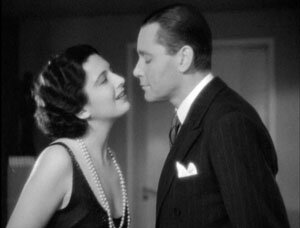 As Peter Bogdanovich mentions in his introduction to the Criterion DVD of the film, it’s a wonder this was ever made in Hollywood, particularly when we see where we are today.
As Peter Bogdanovich mentions in his introduction to the Criterion DVD of the film, it’s a wonder this was ever made in Hollywood, particularly when we see where we are today.
While the troubled triangle of Gaston, Mariette and Lily plays out, the movie also gives us the ineffectual efforts of the Major (Charlie Ruggles) and Francois (Edward Everett Horton), two of Mariette’s luckless suitors. Their ineptness and pretensions provide a nice comedic counterpoint to the sophistication of Gaston.
Much of what Lubitsch does isn’t noticed on first viewing the movie. It is too seamless and fluid. The plot unfolds too effortlessly. It’s only on seeing a second or third or fourth time you see the small details he attends to and just how cleverly the movie is constructed.
In cinema terms, Ernst Lubitsch was a magician. Much of what he does is a kind of sleight of hand — verbal and visual. His movies, like Trouble in Paradise, are mature, charming and absolutely wonderful.
See:
Cary Grant — who was that guy?
I’ve been reading the Marc Eliot biography of Cary Grant (titled, appropriately enough, Cary Grant) and it’s interesting to see how Cary (Archie Leach) was an odd fellow while at the same time, in his oddness, a lot like the rest of us.
There’s a great deal in the book about Grant’s sexuality – was he straight, gay, bisexual, what? Assuming the accuracy of the account, which appears based on inference (though justifiable, I think, given what evidence is available), bisexual would be the best description. And while accurate, in a strictly categorizing way, I think a better descriptive word would be confused. Which is why I think Cary Grant was like the rest of us (though considerably better looking).
He sounds emotionally defensive, probably due to his childhood – like his parents and their relationship (and being told his mother was dead then learning, years later, she was actually in a mental facility). So he sounds like a guy, Archie Leach, who was lonely, having difficulty connecting, who created a persona to present to the world, “Cary Grant.” Cary was the guy up on the screen.
But slowly, after a while, he wondered if perhaps he hadn’t become Cary Grant, the image. Which reminds me of the Kurt Vonnegut line about, “…we are what we pretend to be.”
It’s interesting how we become certain people without necessarily realizing it until, one day, we wonder how we ever became that guy staring back from the mirror.


